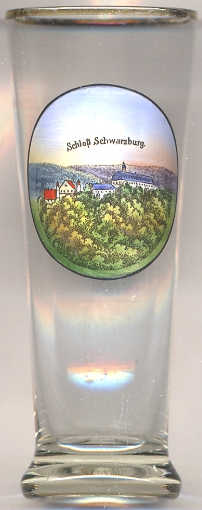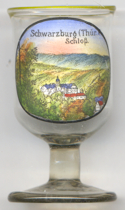

|
| DEUTSCHLAND | GERMANY |
| Bundesland: Freistaat Thüringen | Thuringia |
| Landkreis: Saalfeld-Rudolstadt |
 Schwarzburg is situated at an elevation of 280 m in the valley of the river Schwarza in the Thuringian district Saalfeld-Rudolstadt.
The municipality has a population of about 540 (2012).
Schwarzburg is situated at an elevation of 280 m in the valley of the river Schwarza in the Thuringian district Saalfeld-Rudolstadt.
The municipality has a population of about 540 (2012).
Swartzinburg was first mentioned in 1071. Since the 12th century, Schwarzburg was the ancestral seat of the counts of Schwarzburg. The two principal lines of the family, Schwarzburg-Sondershausen and Schwarzburg-Rudolstadt, were created princes in 1697 and 1710, repectively. During the Middle Ages, Schwarzburg was well-known as a place for gold panning. The river was used to power mills and the village became a local centre of industry up until the 19th century. In the late 19th century Schwarzburg became known for its romantic surroundings and thus was visited by numerous tourists. In 1887 the 'Schwarzburgbund', an association of Christian uniformed student fraternities, was founded here. The first edmocratic constitution of Germany, the Weimar Constitution, was signed here by President of the first German Republic Friedrich Ebert on 11 August 1919.

 Schwarzburg castle [left, no. 2943: background right, and right, no. 4673]
is situated on a steep cliff extending into the Schwarza valley. The oldest document that can be connected with a castle on
this site dates from 1123. The oldest description of the castle is found in a document of 1371. In the 16th century, a new
castle was built, incoporating parts of the former stronghold. Thus, the Leutenberg wing was
created in 1548, the Schwarzburg-Arnstadt-Sondershausen wing in 1559. Since 1584, the castle was
a property of Schwarzburg-Rudolstadt. Starting in 1664 the castle was fortified. When the counts of Schwarzburg-Rudolstadt were elevated to princes of the empire, the fortress was modified until 1744 to
become a representative residence castle, incuding the castle church with the family tombs, the Kaisersaalgebäude ('Imperial Hall wing') with the
adjacent park and a representative gateway; the main wing was rebuilt in Baroque style. In the late 19th century, many Baroque elements were removed and were rebuilt
in Historicist style. After the abdication in 1918 of the last ruling prince, Günther Victor of Schwarzburg-Rudolstadt and Schwarzburg-Sondershausen, the
castle came in possession of the state of Thuringia. However, the princely family retained the right to live in the castle. When the Nazis in 1940 had captured the
Belgian King Léopold III, they decided to detain him in the castle. Shortly after this, it was decided to use the castle as 'Reichsgästehaus'.
For this purpose, large parts of the castle were demolished until 1942 when finally Reichsminister Albert Speer ordered the cessation of the project. The remaining ruins
were secured but no further building activities were carried out. Although several plans to renovate the castle were made in the 1950s, it took until 1994
that some maintenance works were made. Renovation works that began in 2007 are expected to be finished in 2015.
Schwarzburg castle [left, no. 2943: background right, and right, no. 4673]
is situated on a steep cliff extending into the Schwarza valley. The oldest document that can be connected with a castle on
this site dates from 1123. The oldest description of the castle is found in a document of 1371. In the 16th century, a new
castle was built, incoporating parts of the former stronghold. Thus, the Leutenberg wing was
created in 1548, the Schwarzburg-Arnstadt-Sondershausen wing in 1559. Since 1584, the castle was
a property of Schwarzburg-Rudolstadt. Starting in 1664 the castle was fortified. When the counts of Schwarzburg-Rudolstadt were elevated to princes of the empire, the fortress was modified until 1744 to
become a representative residence castle, incuding the castle church with the family tombs, the Kaisersaalgebäude ('Imperial Hall wing') with the
adjacent park and a representative gateway; the main wing was rebuilt in Baroque style. In the late 19th century, many Baroque elements were removed and were rebuilt
in Historicist style. After the abdication in 1918 of the last ruling prince, Günther Victor of Schwarzburg-Rudolstadt and Schwarzburg-Sondershausen, the
castle came in possession of the state of Thuringia. However, the princely family retained the right to live in the castle. When the Nazis in 1940 had captured the
Belgian King Léopold III, they decided to detain him in the castle. Shortly after this, it was decided to use the castle as 'Reichsgästehaus'.
For this purpose, large parts of the castle were demolished until 1942 when finally Reichsminister Albert Speer ordered the cessation of the project. The remaining ruins
were secured but no further building activities were carried out. Although several plans to renovate the castle were made in the 1950s, it took until 1994
that some maintenance works were made. Renovation works that began in 2007 are expected to be finished in 2015.
[https://de.wikipedia.org/wiki/Schwarzburg, https://de.wikipedia.org/wiki/Schloss_Schwarzburg]
![[scale]](lineal.jpg)